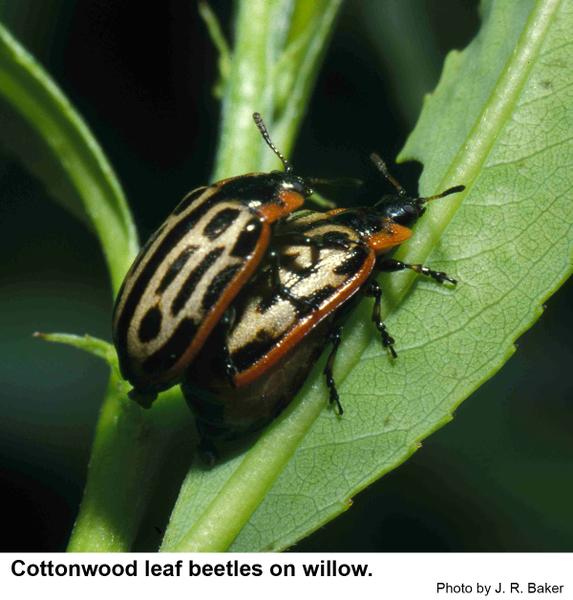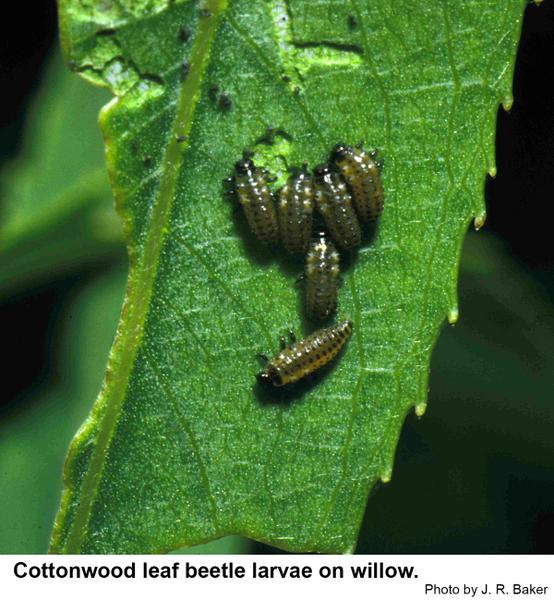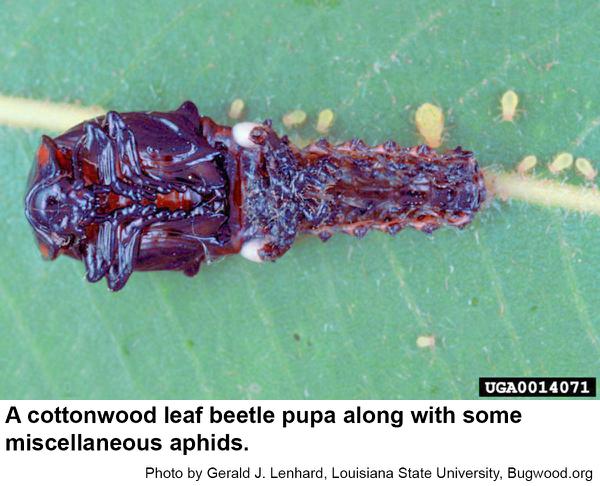Description and Biology
The cottonwood leaf beetle, Chrysomela scripta, feeds on the leaves of willow, poplar, and alder throughout North Carolina. Adults are the overwintering stage and survive the winter to emerge in early spring and feed on the buds, tender new leaves, and tender bark. Tiny yellow eggs are laid in masses of 15 to 75 on the lower leaf surface. Black, tiny, new larvae hatch and feed in groups. Young larvae skeletonize the leaves. As they grow, older larvae separate and consume entire leaves except for the midrib. Older larvae are grayish brown with two rows of conspicuous pale spots down the back. After feeding for about 2 weeks, the larvae pupate on the leaves, stems, trunk, and nearby objects. A new generation of adult beetles emerges in 5 to 10 days. Several generations occur each year.
Host Plants
Cottonwood leaf beetles feed on cottonwood, aspen, poplar and willow throughout North Carolina. The tiny new larvae feed in groups and don't eat much. Young larvae skeletonize the leaves. As they grow older, the larvae separate and consume entire leaves except for the midrib.
Residential Recommendation
Lady beetles and their larvae feed on cottonwood leaf beetle eggs and pupae (cottonwood leaf beetle larvae have a defensive secretion that is effective in repelling predators. A few kinds of predatory stink bugs feed on the beetles. If cottonwood leaf beetles cause noticeable defoliation and if a tree is small enough to treat, various pyrethroid and other insecticides are available in most garden centers. When used as directed, pyrethroids are very toxic to insects but are not particularly hazardous to humans and pets (other than fish-avoid using pyrethroids around pools, ponds, and streams). Be sure to follow the directions on the label of whichever pesticide is used.
References
- Common name: cottonwood leaf beetle, scientific name: Chrysomela scripta Fabricius (Insecta: Coleoptera: Chrysomelidae: Chrysomela). Chi, A. A. and R. F. Mizell, III. 2012. Featured Creatures, Entomology & Nematology, FDACS/DPI, EDIS. EENY-519.
- Cottonwood Leaf Beetle. Oliveria, F. L. and J. D. Solomon. 2004. Forest Pests: Insects, Diseases & Other Damage Agents.
- Extension Plant Pathology Publications and Factsheets
- Horticultural Science Publications
- North Carolina Agricultural Chemicals Manual
For assistance with a specific problem, contact your local N.C. Cooperative Extension Center.
This Factsheet has not been peer reviewed.
Publication date: Nov. 19, 2012
Reviewed/Revised: Sept. 12, 2019
Recommendations for the use of agricultural chemicals are included in this publication as a convenience to the reader. The use of brand names and any mention or listing of commercial products or services in this publication does not imply endorsement by NC State University or N.C. A&T State University nor discrimination against similar products or services not mentioned. Individuals who use agricultural chemicals are responsible for ensuring that the intended use complies with current regulations and conforms to the product label. Be sure to obtain current information about usage regulations and examine a current product label before applying any chemical. For assistance, contact your local N.C. Cooperative Extension county center.
N.C. Cooperative Extension prohibits discrimination and harassment regardless of age, color, disability, family and marital status, gender identity, national origin, political beliefs, race, religion, sex (including pregnancy), sexual orientation and veteran status.




